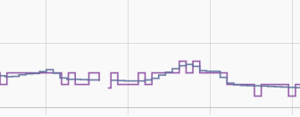Pulse Meter Sensor¶
The pulse meter sensor allows you to count the number and frequency of pulses on any pin. It is intended to be a drop-in replacement
for the pulse counter component.
Rather than counting pulses over a fixed time interval, the pulse meter sensor measures the time between pulses. The precise manner in which this is done depends on the internal_filter_mode option. This leads to a higher resolution, especially for low pulse rates, as the pulse counter sensor is limited by the number of pulses within a time interval.
Here’s a comparison of the two sensors. The pulse meter is the smoother line. Both are set to an update interval of 10 seconds (using the update_interval and the throttle_average option respectively):

Please note that it is not possible to use both of these two sensors on the same pin at the same time.
# Example configuration entry
sensor:
- platform: pulse_meter
pin: GPIOXX
name: "Pulse Meter"
Configuration variables¶
pin (Required, Pin): The pin to count pulses on.
internal_filter (Optional, Time): If a pulse shorter than this time is detected, it is discarded. Defaults to
13us.This acts as a debounce filter to eliminate input noise, so choose a value a little less than your expected minimum pulse width.
internal_filter_mode (Optional, string): Determines how the internal filter is applied. One of
EDGEorPULSE. Defaults toEDGE. - InEDGEmode, subsequent rising edges are compared and if they fall into an interval lesser than theinternal filtervalue, the last one is discarded. This is useful if your input signal bounces, but is otherwise clean. - InPULSEmode, the rising edge is discarded if any further interrupts are detected before theinternal_filtertime has passed. In other words, a high pulse must be at leastinternal_filterlong to be counted. This is useful if you have a noisy input signal that may have bounces before and/or after the main pulse.timeout (Optional, Time): If we don’t see a pulse for this length of time, we assume 0 pulses/s. Defaults to
5 min.total (Optional, ID): An additional sensor that outputs the total number of pulses counted.
All other options from Sensor.
Converting units¶
The sensor defaults to units of pulses/min, You can change this by using Sensor Filters. For example, if you’re using the pulse meter with a photodiode to count the light pulses on a power meter that has an impulse constant of 10000 pulses / kWh, you can use the following to output instantaneous usage in W:
# Example configuration entry
sensor:
- platform: pulse_meter
name: 'Electricity Usage'
id: sensor_pulse_meter # Optional ID, necessary if you want to calculate the total number of pulses.
unit_of_measurement: 'W'
device_class: power
state_class: measurement
internal_filter: 20ms # Assuming maximum load of 16 kW and 10000 impulses per kWh, any pulses faster than 22.5 ms would exceed load. -10% ~= 20 ms.
accuracy_decimals: 0
pin: GPIOXX
filters:
- multiply: 6 # (60s / impulse constant) * (1000W / 1kW)
Counting total pulses¶
When the total sensor is configured, pulse_meter also reports the total
number of pulses measured.
# Example configuration entry
sensor:
- platform: pulse_meter
# ...
total:
name: "Total Pulses"
(Re)Setting the total pulse count¶
Using this action, you are able to reset/set the total pulse count. This can be useful
if you would like the total sensor to match what you see on your meter you are
trying to match.
api:
actions:
- action: set_total
variables:
new_total: int
then:
- pulse_meter.set_total_pulses:
id: sensor_pulse_meter
value: !lambda 'return new_total;'
Note
This value is the raw count of pulses, and not the value you see after the filters